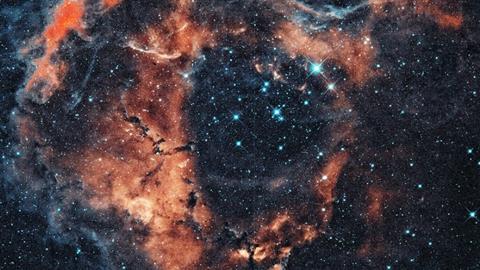Writer Steve Schramm investigates the Big Bang theory and explores its implications
For centuries, people have looked to the stars and wondered about the Universe. What is out there? How did it all begin?
In the 20th Century, scientists developed a theory called the Big Bang, the cosmology of which seeks to answer these questions. According to this theory, the Universe came into existence at a finite point in the past.
Some people believe that this evidence supports the idea of a creator God who made everything come into being, while others maintain that the Universe essentially “popped into existence out of nothing”.
Read more:
How studying Hawking’s Big Bang led me to God
‘Science is not enough’
Is science at odds with religion?
Finding God through science
Admitting biases
Since the Big Bang Theory (BBT) was first proposed, there has been wide debate amongst Christians as to whether or not the Big Bang actually happened, which will be discussed in more detail below.
This author is sceptical that the BBT is taught by scripture or supported by science. Nevertheless, it will be argued that if the Big Bang did happen, it is evidence of a creator fitting the description given by the Hebrew and Christian scriptures.
What is Big Bang cosmology?
A cosmology is a holistic set of data that, taken together, explains numerous features about the origin and development of the Universe. In a limited sense, cosmology can begin to help us understand fundamental human questions such as, “Where did we come from?” and “Why are we here?”.
Since around the middle of the 20th Century, modern cosmology has been dominated by the Big Bang Theory. The BBT is posited to explain how the Universe came into existence and developed into the world we know today.
The BBT has been incredibly successful at accounting for a wide range of empirical data. In fact, it is widely considered to be the most accurate description of the Universe that we currently have. That being said, the theory is not without its detractors.
Summary of the theory
A brief and oversimplified version of the BBT might be this: Around 14 billion years ago, there was a hot, dense singularity that went through a very rapid initial expansion phase (called the Inflationary Epoch), which then slowed. Think of this expansion akin to one blowing up a balloon and its surface expanding.
Due to the effects of this expansion, gravity, the formation of heavy elements, galaxies, solar systems, stars and planets eventually began to form. The Universe is still rapidly expanding, evolving, and cooling down today.
Billions of years from now, the Universe will cool to the point that all of its usable energy is gone (due to The Second Law of Thermodynamics) and will become cold and lifeless. Christian scientists who believe in the BBT generally suggest that the final resurrection and return of Christ will take place prior to the naturalistic inevitability of the Universe’s so-called “heat death”.
Evidence for the Big Bang
One publication presents the following four pieces of evidence that the BBT is true:
Redshift of galaxies. As we observe the skies with increasing distance, we see an increasing shift toward the red spectrum of light. This is taken to be evidence that the Universe is expanding (galaxies are moving further away from each other), and if the tape were rewound, everything would be much closer until you’d eventually see the singularity mentioned above.
Cosmic microwave background radiation. There is an ostensibly even distribution of radiation across the Universe that cannot be easily explained. The BBT could explain this because the Universe initially was much smaller and hotter. Traces of that heat (in the form of microwave radiation) would be expected and has been observed.
Mixture of Elements. Certain elements would have existed in the early formation of stars and planets that are different from those in more recent ones. The BBT predicts these elements and observations seem prima facie consistent.
Looking back in time. Because of the expansion of the Universe and the time it takes for light to travel, cosmologists believe that the further out into the Universe one looks, the further back in time one sees. This would make deep space astronomy akin to looking back in time. This would mean one could theoretically examine the very origin moment of the Universe itself (assuming one could look back far enough), which in turn assumes the Universe came into existence at a finite period in the past. This logically precludes the possibility of the BBT’s longest-reigning competitor, the Steady State Theory, which proposes that the Universe itself is both infinite and eternal.
Of course, this theory has been changing and developing over the past half a century, plus. Interestingly, the initial presentation of the BBT was met with resistance by the mainstream scientific community because of how well it seemed to go along with what Genesis 1 claimed about the beginning of the Universe.
Christian agreements and disagreements with the Big Bang
The historical Jewish and Christian position on the age of creation is that the Universe is on the order of 6,000-10,000 years old. The introduction of Big Bang Cosmology has contributed to a widespread (although not wholesale) rejection of that timeline, even inside these institutions.
Those Christians who do accept Big Bang Cosmology may still differ widely on the question of biological evolution and the relationship of organisms to one another. Suffice it to say, Christians who accept the BBT generally do not take issue with anything that follows from it, including the origin of our solar system, the geographic history of the Earth and moon, etc.
In their case, a reinterpretation of the scriptures that seem to suggest a recent, six-day creation (notably the days of Genesis 1, the global flood in Genesis 6-8 and the genealogies in Genesis 5 and 11) has been necessary. Such reinterpretations can be found in the works of Drs Hugh Ross, John Lennox, Michael Strauss and others.
Some Christians (primarily young earth creationists) remain sceptical that the BBT is true. While they enjoy the benefit of holding the traditional and historic interpretations of the scriptures, they admittedly bear the mountainous weight of rejecting the evidence discussed above for the BBT.
Although there is no space here to offer a lengthy response from these creationists to the aforementioned evidence, a brief sketch of the response would be as follows:
Redshift of galaxies. Creationists do not doubt the Universe is expanding. Some have suggested that, by positing a set of initial conditions consistent with the description of creation in Genesis 1, it is possible to observe this redshift without assuming a uniformitarian approach (discussed below).
Cosmic microwave background radiation. The CMB has no universal explanation among creationists, although some suggestions have been put forward. Dr Danny Faulker, a creationist astronomer, has noted the CMB is a legitimate prediction of the BBT and is admittedly difficult to explain any other way.
Mixture of elements. Creationists argue that this evidence is explanatory rather than predictive. In other words, information regarding elements is used as pieces of input for various models, meaning the models can be tweaked and would be internally inconsistent if the “predictions” were not true.
Looking back in time. Similar to #1, the notion that astronomers “look back in time” when observing the heavens depends on the very assumption that all rates, conditions and processes we know today have been consistent since the beginning of the Universe.
Items 1 and 4 above depend upon the assumption of “uniformitarianism”. This is the view (which originated in the field of geology but now pervades the sciences) that all rates, conditions, processes and laws we observe today have been consistent since the beginning of the Universe.
Since creation is regarded as a supernatural event and God does not promise uniformity or consistency in nature until after the flood (see Genesis 8:22), it is argued that to assume uniformitarianism is to prima facie disregard the Bible’s take on these events, which is logically problematic.
If one were to shed the assumption of uniformitarianism, the redshift of galaxies and the relationship between light and distance could have alternative (and biblically consistent) explanations.
Get access to exclusive bonus content & updates: register & sign up to the Premier Unbelievable? newsletter!
What the evidence tells us
While the Big Bang is arguably naturalistic in nature and, in its details, may not be immediately consistent with the biblical data, there is no denying that it is conceptually consistent with the notion of a creator God.
As a matter of fact, the BBT’s greatest weakness is that, apart from a supernatural explanation, it offers very little in the way of explaining how there is something rather than nothing. In his book, A Universe from Nothing, Dr Lawrence Krauss argues from the field of quantum physics that it is possible a Universe could truly “pop into existence” out of nothing.
However, such a suggestion is philosophically problematic. Dr Krauss appeals to the “quantum vacuum” of empty space. This, of course, fails to recognise that the vacuum is something! When we say “creation out of nothing”, we mean “out of not anything”.
With this in view, secular adherents to the BBT remain without an explanation for the existence of the initial singularity that expanded into the Universe we know today. Thus, even if the BBT successfully explains the expansion of the Universe, it does not successfully explain the existence of the Universe.
Therefore, if Big Bang Cosmology is true, it is clearly more consistent with “creation out of nothing” as presented by the Bible than naturalism.
Steve Schramm is an autodidactic writer, Bible teacher and host of the Bible Nerd Podcast. He’s authored four books, including Truth Be Told: A Believer’s Guide to Sharing Christianity, Overcoming Objections, and Winning More Souls for Christ























